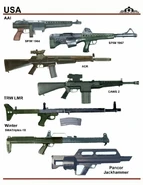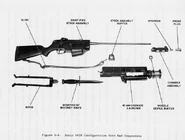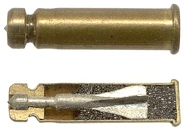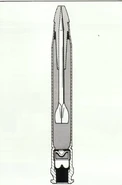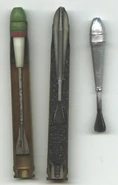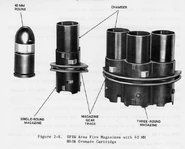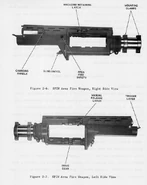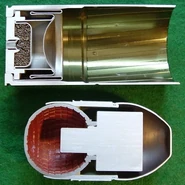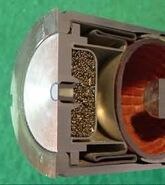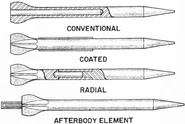The AAI SPIW was a prototype assault rifle designed for the Special Purpose Individual Weapon program.
History[]
Four designers submitted their firearm designs for a future assault rifle in the SPIW program; Harrington & Richardson, Winchester, Springfield Armory and AAI Corporation.
Of all the four designs, the AAI design was the most basic. The AAI design was also the only design to continue using the XM110 round provided. The flechette portion was somewhat heavy, but the weapon fired at a rate of 2,400 rounds per minute in burst mode. It also had a single-shot grenade launcher mounted underneath. Eventually, the AAI's rifle was considered for development.
After a few months, the AAI design, now with a complete three-round grenade launcher, was tested. However, it was not reliable and the M16 rifle continued to be used, and the project was discontinued.
While none of the designs were successful, the grenade launcher mounted on the AAI prototype was considered successful, giving birth to the famed M203 grenade launcher.
Design Details[]
The AAI design was the least advanced of all four designs. It was considered to be the lightest, simplest, and the most durable.
The 1964 first-generation prototype of the SPIW used a three-shot, lever-action grenade launcher on the underside of the barrel. The grenade launcher component could hold two shots in a tube magazine, and the third in the chamber. The goal of making a modern grenade launcher was a leftover from Project NIBLICK before it combined with the APHHW (All-Purpose Hand-Held Weapon) program and evolved into the SPIW program with the goal of combining a flechette firing rifle with a grenade launcher.
The second-generation prototype developed in 1966 made some improvements on the previous generation. The first is a new stock made of plastic. The second, is that it uses the 5.6×57mm XM645, a redesign of the previous XM110 round. Because of the extra 4mm in length for the round's casing, the drum magazine and action stroke were made slightly larger to accommodate the new cartridge. While they were technically smoothbore guns, they had slight rifling at the very end of the muzzle called a spinning cutter, its purpose was to spin the sabot and fling it off the flechette as it left the barrel. In addition, as another means of reducing the weapon's weight, AAI developed the DBCATA disposable grenade launcher system. Launcher-plates for DBCATA came in both single-shot and three-shot capacities. The three-shot DBCATA launcher-plate used a harmonica-style loading system.
1967 to 1968 saw AAI introduce a family of third-generation SPIW weapons. This included a belt-fed light machine gun, a point-fire rifle with a centrally mounted bipod, a short-barreled variation, a bullpup submachine gun model with the magazine behind the pistol grip, and a redesign of the 1966 prototype with a single-shot DBCATA launcher-plate. Due to complaints about the muzzle flash and noise level of the weapon, a silencer was added to the barrel.
The last variation of the SPIW had the capability to have its foregrip changed out for a grenade launcher component that costs less than DBCATA. The grenade launcher is fed from single-tube or three-tube magazines with standard 40mm grenades loaded in them. The magazine feeds into the launcher from the side, with the magazine having a gear track that hooks onto a rail in the launcher.
Ammunition[]
The first-generation AAI SPIW fired the XM110, a 5.6×53mm caliber flechette round designed by Irwin R. Barr. Later generations of the weapon used the improved 5.6×57mm XM645 round. An early form of the ammunition used the .22 LR cartridge as a parent.
Variants[]
The 1967/8 SPIW had a LMG variant, a bullpup SMG variant, and a point-fire variant among others. It also spawned two other similar weapons, the XM19 and the XM70.
Gallery[]
See also[]
- Special Purpose Individual Weapon
- Flechette
- 5.6×53mm XM110
- 5.56×57mm XM645
- Project NIBLICK
- DBCATA
- Winchester SPIW
- Springfield Armory SPIW
- H&R SPIW
References[]
- Forgotten Weapons video on AAI 2nd Gen SPIW
- Forgotten Weapons article on AAI 2nd Gen SPIW
- Pew Pew Pew article on AAI SPIW (Chinese)
- Revisiting the SPIW part II
- SPIW on ModernFirearms.net
- SPIW on LooseRounds.net
- PDF on SPIW modes of fire
- Cartridge Collectors Cartridge of the Month February 2010: DBCATA
- Imgur page about the DBCATA
- Wikipedia article on SPIW










